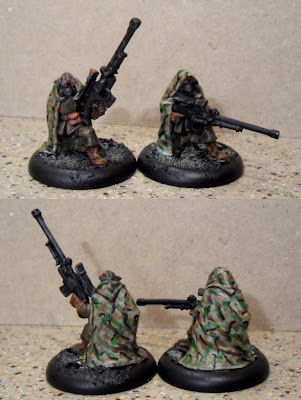It's been a few years since I last played any Two Hour Wargames game. To be honest I'd stopped playing as they kept changing their core mechanic - the In Sight test, and I kept falling behind on rule revisons. But with the release of their free Chain Reaction 3 - Final Version there was a statement of intent that the mechanics were now finalised and future development was to be on genre, etc only.
Time to step back into the fold then and check out the new workings...
Arabiansquire and myself set up round a table at our local club. For simplicity we had small and similar squads:
AS (Space Marine figures):
- Leader: Rep 5, Machine Pistol
- Grunts x3: Rep 4, Assault Rifle
- Heavy: Rep 4, Rocket Launcher
AK (Urban War Viridians):
- Leader: Rep 5, Machine Pistol
- Grunts x3: Rep 4, Assault Rifle
- Heavy: Rep 4, Squad Automatic Weapon (aka S.A.W.)
We had a busy table, as the majority of weapons had a 48" range, which was pretty much the entire table. One of the good things about even these basic rules is that some of the solo play mechanics leak into the Head-to-Head. Right from the start the P.E.F. (Possible Enemy Forces) mechanic comes into play. Players secretly split their force into two or more groups and then use tokens to move around the table until the token come into sight. Decoy tokens are allowed and act as "false alarms". I like this "Fog of War" mechanic as I've never like the way we can see the opposite forces (heavy machine gun or leader for example) right from the off.
Enemy forces move and take position - or do they?
First squad resolution - a 3 man squad (with Rocket Launcher) come onto a roof top...
spotted by a 2 man crew in another building (with S.A.W.)
Despite fire going between the buildings no-one was hit. The effect of the Rocket Launcher was still felt in the reaction tests as the Marines ducked back out of sight due to being outgunned.
A second group of marines moved to flank but were spotted. Another nice "real life" aspect of the reaction rules is that models can continue to move an extra 2" once spotted, giving the effect of a "fleeting glimpse" or delay whilst guns are levelled Here it meant that the first member of the group activated the enemy, but only the rearguard was involved once the bullets started to fly.
Another change from the old rules is that every figure takes the insight reaction test at the same time and an order of reaction is established, although the stationary figure does still retain an advantage in deciding the order. Gun fire can quite often go back and forth for several shots before someone goes down or is beaten back into cover. In this case the Space Marine on the building top came off worse going "Out of Fight" (effectively dead for the purposes of a single battle)
With the reaction fire concluded, the flanking group then continued the rest of their activated movement round the corner.
Meanwhile the Marine S.A.W. was fairing less well against the Space Marine Missile Launcher. Despite firing off a few rounds at his opponent, the Marine soon found that when the Missile does hit, it's not a good thing!
We ran out of time for any other action, what with all the looking up of rules, etc. As with most rulesets, but especially Two Hour Wargames ones, they really do have to be played to see what they do. THW rules always seem very clunky with tonnes of table references, but in reality when the action starts flowing there are only two or three tables used, and the outcomes become known very quickly. there is still a bit of deciphering to be done on certain reaction effects (ducking back being one) but we'll get there.
To be played again...







































